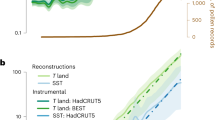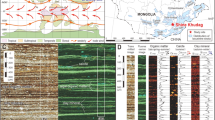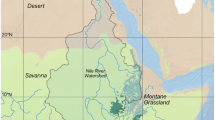Abstract
The late Pliocene (∼3–2.6 million years ago) is an interval of exceptional interest for understanding the Earth's climate system. It was a time of progressive global cooling, resulting in the growth of large terrestrial ice sheets and the initiation of extensive Northern Hemisphere glaciation1,12. The build up of the ice sheets was cyclical and apparently paced by the orbitally driven oscillations in incoming solar radiation (Milankovitch cycles) at periods of approximately 41 kyr (obliquity) and 23–19 kyr (precession). Here we present a high-resolution continental record of late Pliocene climate change, detailing the response of terrestrial vegetation to this interval of dramatic global environmental change. The annually laminated sequence of lake sediments from Pula maar, in Hungary, represents approximately 320 kyr of accumulation between ∼3.0 and 2.6 million years ago. Spectral analyses of the record indicate terrestrial responses to incoming solar radiation at obliquity and precession periodicities, but the strongest response appears at a period of ∼124 kyr. Calculations indicate that variations in insolation forcing at this periodicity were negligible at this time. The Pula record thus demonstrates that internally driven nonlinear responses of the climate system, at a period of ∼124 kyr, were at least as important as external forcing at the orbital frequencies of precession and obliquity in driving late Pliocene large-scale environmental change.
This is a preview of subscription content, access via your institution
Access options
Subscribe to this journal
Receive 51 print issues and online access
$199.00 per year
only $3.90 per issue
Buy this article
- Purchase on Springer Link
- Instant access to full article PDF
Prices may be subject to local taxes which are calculated during checkout




Similar content being viewed by others
References
Shackleton, N. J., Hall, M. A. & Pate, D. Proc. ODP Sci. Res. 138, 337–345 (1995).
Maslin, M. A., Haug, G. H., Sarnthein, M. & Tiedemann, R. The progressive intensification of northern hemisphere glaciation as seen from the North Pacific. Geol. Rundsch. 85, 452–465 (1996).
Zimmerle, W. in Paleolimnology of European Maar Lakes (eds Negendank, J. F. W. & Zolitschka, B.) 1–511 (Springer, Berlin, 1993).
Ravasz, C. in Annual Report of the Hungarian State Geological Instutite for 1974 221–245 (Hungarian Geol. Inst., Budapest, (1976).
Balogh, K. et al. in Annual Report of the Hungarian State Geological Institute for 1980 243–260 (Hungarian Geol. Inst., Budapest, (1982).
Cande, S. C. & Kent, D. V. Anew geomagnetic polarity timescale for the Late Cretaceous and Cenozoic. J. Geophys. Res. 97, 13917–13951 (1992).
Kukla, G. Loess stratigraphy in central China. Quat. Sci. Rev. 6, 191–219 (1987).
Birks, H. J. B. & Gordon, A. D. Numerical Methods in Quaternary Pollen Analysis (Academic, London, 1985).
Hajós, M. in Annual Report of the Hungarian State Geological Institute for 1988 5–13 (Hungarian Geol. Inst., Budapest, (1989).
Heinz, T., Rein, B. & Negendank, J. F. W. in Paleolimnology of European Maar Lakes (eds Negendank, J. F. W. Zolitschka, B.) 149–161 (Springer, Heidelberg, 1993).
van der Hammen, T., Wijimstra, T. A. & Zagwijn, W. H. in The Late Cenozoic Glacial ages (ed. Turekian, K. K.) 391–424 (Yale Univ. Press, New Haven, 1971).
Tallis, J. H. Plant Community History. Long-term Changes in Plant Distribution and Diversity (Chapman & Hall, London, 1991).
Suc, J. P. et al. Zanclean (Brunssumian) to early Piacenzian (early-middle Reuverian) climate from 4° to 54° north latitude (West Africa, West Europe and West Mediterranean areas). Meded. Rijks Geol. Dienst 52, 43–56 (1995).
Jenkins, G. M. & Watts, D. G. Spectral Analysis and Its Applications (Holden Day, San Francisco, 1968).
Laskar, J., Joutel, F. & Boudin, F. Orbital, precessional and insolation quantities for the Earth from 20 Myr to 10 Myr. Astron. Astrophys. 270, 522–533 (1993).
Aitchinson, J. & Brown, J. A. C. The Lognomial Distribution (Cambridge Univ. Press, 1969).
Tiedemann, R., Sarnthein, M. & Shackleton, N. J. Astronomic timescale for the Pliocene Atlantic δ18O and dust records of Ocean Drilling Program Site 659. Paleoceanography 9, 619–638 (1994).
Thiede, J. & Myhre, A. M. Proc. ODP Sci. Res. (eds Thiede, J., Myhre, A. M., Firth, J. V., Johnson, G. L. & Ruddiman, W. F.) 645–659 (1996).
Cronin, T. M., Raymo, M. E. & Kyle, K. P. Pliocene (3.2–2.4 Ma) ostracode faunal cycles and deep ocean circulation, North Atlantic Ocean. Geology 24, 695–698 (1996).
Tiedemann, R., Sarnthein, M. & Shackleton, N. J. Astronomic timescale for the Pliocene Atlantic 18O and dust flux records of Ocean Drilling Program site 659. Paleoceanography 9, 619–638 (1994).
Rea, D. K. The paleoclimatic record provided by eolian deposition in the deep sea: the geologic history of wind. Rev. Geophys. 32, 159–195 (1994).
Acknowledgements
We thank K. D. Bennett, S. Clemens, M. Chapman, C. A. G. Gilligan, C. Heusser, M.F. Loutre, J. C. Ritchie, N. J. S. Shackleton and L. P. Zhou for comments and discussions on this manuscript, and B. Goddard for help with the figures. This work was funded by a Royal Society University Research Fellowship (K.W.) and a King's College Senior Research Fellowship (A.K.).
Author information
Authors and Affiliations
Corresponding author
Rights and permissions
About this article
Cite this article
Willis, K., Kleczkowski, A. & Crowhurst, S. 124,000-year periodicity in terrestrial vegetation change during the late Pliocene epoch. Nature 397, 685–688 (1999). https://doi.org/10.1038/17783
Received:
Accepted:
Issue Date:
DOI: https://doi.org/10.1038/17783
This article is cited by
-
Pre-Quaternary divergence and subsequent radiation explain longitudinal patterns of genetic and morphological variation in the striped skink, Heremites vittatus
BMC Evolutionary Biology (2017)
-
Structure of the Pliocene Camp dels Ninots maar-diatreme (Catalan Volcanic Zone, NE Spain)
Bulletin of Volcanology (2015)
-
Fossil records of subsection Pinus (genus Pinus, Pinaceae) from the Cenozoic in Japan
Journal of Plant Research (2014)
-
Short-term fluctuations in vegetation and phytoplankton during the Middle Eocene greenhouse climate: a 640-kyr record from the Messel oil shale (Germany)
International Journal of Earth Sciences (2011)
-
Paleoenvironmental evolution of the Pliocene Villarroya Lake, northern Spain, from stable isotopes and trace-element geochemistry of ostracods and molluscs
Journal of Paleolimnology (2008)
Comments
By submitting a comment you agree to abide by our Terms and Community Guidelines. If you find something abusive or that does not comply with our terms or guidelines please flag it as inappropriate.



